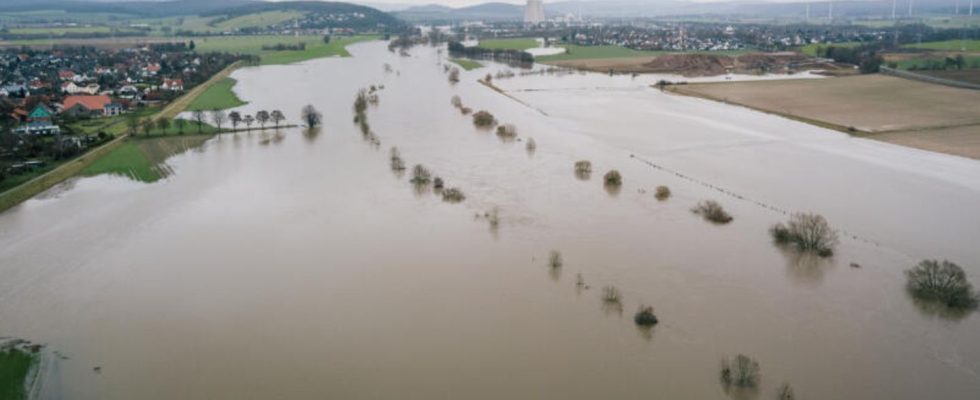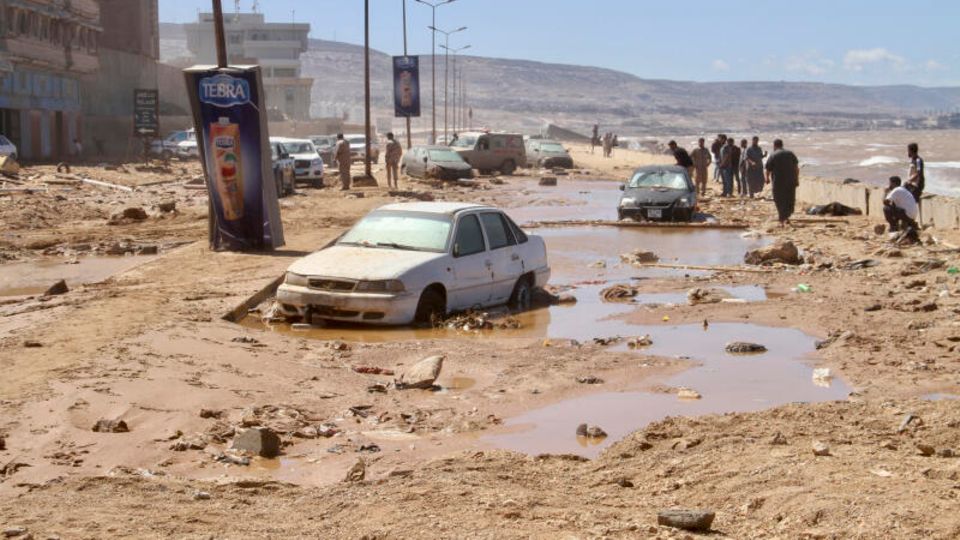questions and answers
What are floods, storm surges, etc.? The most important terms explained
Meadows and fields near Türndern in Lower Saxony. The flooding of the Weser flooded large areas in the last weeks of December 2023.
© Ole Spata / DPA
Areas across Germany are flooded. Days of rain have led to high water levels in many places. But when do we actually talk about floods, storm surges or tidal waves?
Towns throughout Germany are struggling with high water levels. Particularly in parts of Saxony, Thuringia, Lower Saxony and North Rhine-Westphalia Rivers, streams and lakes massively swollen. Days of continuous rain hit soil that had sometimes been parched for months. In many cities and communities, water is already standing in fields and flooding streets. In some districts, people had to leave their homes as a precaution to avoid being trapped by the floodwaters.
For days now, the situation has been described naturally using terms such as flooding or storm surge. But when do these terms even begin to be used? The star provides information.
When do we start talking about floods?
Basically, floods are natural events. In maritime waters and connected rivers, the term describes the highest water level during the flood (mean high water). On the contrary, low tide is the lowest level during low tide. The Domestic Water Act defines flooding as “temporary flooding from land not normally covered with water by surface waters or by seawater entering coastal areas.”
According to the Federal Environment Agency, regular floods have an important ecological function. Animals and plants on river floodplains, for example, have adapted to the interplay between flooding and drying out. In areas where floods occur frequently, residents are usually well prepared for these events and damage is very rare. An example of this is the city Hamburgwhere the floodwaters of the Elbe flood the St. Pauli fish market several times a year.

Almost everyday life for Hamburg residents, a highlight for tourists: several times a year, the floodwaters of the Elbe flood the St. Pauli fish market. Damage is extremely rare here.
© Thomas Müller / DPA
The reasons for flooding of non-tidal bodies of water such as lakes or smaller rivers are usually due to an interaction between precipitation and sealed soils. Particularly long-lasting or shorter but particularly intense ones Rainfall hits soil that can no longer absorb the amount of water. This is particularly common in winter, when the ground is frozen and water cannot seep away, while precipitation or melting snow causes rivers and streams to swell into raging torrents.
What is a storm surge?
In Germany, a DIN standard even defines what exactly a storm surge is. Accordingly, such an event is called ““Raising of water on the sea coast and in the estuaries in the coastal area caused by strong winds when the water levels exceed a certain value”. Or to put it more simply: Storm surges are caused by strong winds pushing sea water towards the coast or into the ” “German Bay” and thus increase the water levels.
From a water level of 1.5 meters above mean high water, the Federal Maritime and Hydrographic Agency (BSH) warns of a storm surge. In Hamburg, for example, such a storm surge is only perceived as a significantly higher water level. From 2.5 meters above the mean high water the classification “severe storm surge” applies; from 3.5 meters above the mean high water it is referred to as a very severe storm surge.
However, it cannot be said in general terms whether water levels at this height have any impact and whether flooding will occur. This depends on the structural conditions and the surrounding area.
What is a “rival tide”?
The spring tide is commonly, although incorrectly, referred to as a “spring tide”. It is a particularly strong form of tide, occurs twice a month and is the result of a special one sun-earth-moonConstellation. Ebb and flow are influenced by the gravity of the moon and sun. If the sun and moon lie on an imaginary line with the earth, the attractive forces add up.
Christmas floods
The flood situation is easing to some extent – the risk of heavy rain is increasing again
The result is a stronger ebb or flow, which “pulls back” the water in seas or adjacent rivers particularly strongly and then “pushes it forward” again. The spring tide is a natural phenomenon and usually happens without any particular impact.
What is a tidal wave?
Anyone who thinks of tidal waves as rising masses of water or even something like tsunamis is on the wrong track. The very waves that break when they hit land are often incorrectly referred to as tidal waves. The explanation is obvious: a wave that triggers a flood, i.e. a flood.
But this explanation is a misconception. The Hydrography defines a tidal wave simply as a “regularly recurring shallow water wave caused by the effects on the ocean of gravitational interactions between the Sun, Moon and Earth.” A tsunami, on the other hand, is triggered by an external event such as an underwater earthquake and is not caused by the tides.
What is a flash flood?
A flash flood is a particular challenge for disaster and water conservationists. Scientists define it as a sudden flood, for example due to a dam bursting or extreme rainfall, in which neither the ground nor the sewage system can absorb the precipitation, and surface waterways form.
In September, two dams burst near Darna in Libya. The flash flood flooded the port city within a very short time, costing tens of thousands of people their lives.
© Yousef Murad / AP / DPA
Flash floods are considered dangerous because they occur quickly and unpredictably. They are particularly dangerous when heavy rain falls in dry areas. The waterways can have destructive power, sweeping away entire buildings and moving for several kilometers. Water levels as low as 50 centimeters can wash away cars.
Sources: Hamburg.de, Federal Environment Agency, German Weather Service, Bavarian state government


